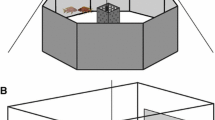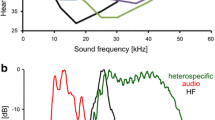Abstract
The weakly electric fish Apteronotus leptorhynchus produces wave-like electric organ discharges distinguished by a high degree of regularity. Transient amplitude and frequency modulations (“chirps”) can be evoked in males by stimulation with the electric field of a conspecific. During these interactions, the males examined in this study produced six types of chirps, including two novel ones. Stimulation of a test fish with a conspecific at various distances showed that two electrically interacting fish must be within 10 cm of each other to evoke chirping behavior in the neighboring fish. The chirp rate of all but one chirp type elicited by the neighboring fish was found to be negatively correlated with the absolute value of the frequency difference between the two interacting fish, but independent of the sign of this difference. Correlation analysis of the instantaneous rates of chirp occurrence revealed two modes of interactions characterized by reciprocal stimulation and reciprocal inhibition. Further analysis of the temporal relationship between the chirps generated by the two fish during electric interactions showed that the chirps generated by one individual follow the chirps of the other with a short latency of approximately 500–1000 ms. We hypothesize that this “echo response” serves a communicatory function.






Similar content being viewed by others
Abbreviations
- Δf :
-
Frequency of partner fish’s electric organ discharge minus frequency of test fish’s electric organ discharge
- EOD :
-
Electric organ discharge
References
Bastian J, Schniederjan S, Nguyenkim J (2001) Arginine vasotocin modulates a sexually dimorphic communciation behavior in the weakly electric fish Apteronotus leptorhynchus. J Exp Biol 204:1909–1923
Bauer R, Kramer B (1974) Agonistic behaviour in mormyrid fish: latency-relationship between the electric discharges of Gnathonemus petersii and Mormyrus rume. Experientia 30:51–52
Bullock TH (1969) Species differences in effect of electroreceptor input on electric organ pacemakers and other aspects of behavior in electric fish. Brain Behav Evol 2:85–118
Dulka JG, Maler L (1994) Testosterone modulates female chirping behavior in the weakly electric fish, Apteronotus leptorhynchus. J Comp Physiol A 174:331–343
Dunlap KD (2002) Hormonal and body size correlates of electrocommunication behavior during dyadic interactions in a weakly electric fish, Apteronotus leptorhynchus. Horm Behav 41:187–194
Dunlap KD, Thomas P, Zakon HH (1998) Diversity of sexual dimorphism in electrocommunication signals and its androgen regulation in a genus of electric fish, Apteronotus. J Comp Physiol A 183:77–86
Dye J (1987) Dynamics and stimulus-dependence of pacemaker control during behavioral modulations in the weakly electric fish, Apteronotus. J Comp Physiol A 161:175–185
Enger PS, Szabo T (1968) Effect of temperature on the discharge rates of the electric organ of some gymnotids. Comp Biochem Physiol 27:625–627
Engler G, Fogarty CM, Banks JR, Zupanc GKH (2000) Spontaneous modulations of the electric organ discharge in the weakly electric fish, Apteronotus leptorhynchus: a biophysical and behavioral analysis. J Comp Physiol A 186:645–660
Engler G, Zupanc GKH (2001) Differential production of chirping behavior evoked by electrical stimulation of the weakly electric fish, Apteronotus leptorhynchus. J Comp Physiol A 187:747–756
Hagedorn M (1986) The ecology, courtship, and mating of gymnotiform electric fish. In: Bullock TH, Heiligenberg W (eds) Electroreception. John Wiley & Sons, New York, pp 497–525
Hagedorn M, Heiligenberg W (1985) Court and spark: electric signals in the courtship and mating of gymnotoid fish. Anim Behav 33:254–265
Heiligenberg W (1973) Electrolocation of objects in the electric fish Eigenmannia (Rhamphichthyidae, Gymnotoidei). J Comp Physiol 87:137–164
Hopkins CD (1974) Electric communication: functions in the social behavior of Eigenmannia virescens. Behaviour 50:270–305
Hopkins CD (1976) Stimulus filtering and electroreception: tuberous electroreceptors in three species of gymnotoid fish. J Comp Physiol A 111:171–207
Hopkins CD (1986) Behavior of Mormyridae. In: Bullock TH, Heiligenberg W (eds) Electroreception. John Wiley & Sons, New York, pp 527–576
Knudsen EI (1974) Behavioral thresholds to electric signals in high frequency electric fish. J Comp Physiol 91:333–353
Knudsen EI (1975) Spatial aspects of the electric fields generated by weakly electric fish. J Comp Physiol 99:103–118
Larimer JL, MacDonald JA (1968) Sensory feedback from electroreceptors to electromotor pacemaker centers in gymnotids. Am J Physiol 214:1253–1261
Maler L, Ellis WG (1987) Inter-male aggressive signals in weakly electric fish are modulated by monoamines. Behav Brain Res 25:75–81
Metzner W (1999) Neural circuitry for communication and jamming avoidance in gymnotiform electric fish. J Exp Biol 202:1365–1375
Meyer JH, Leong M, Keller CH (1987) Hormone-induced and maturational changes in electric organ discharges and electroreceptor tuning in the weakly electric fish Apteronotus. J Comp Physiol A 160:385–394
Moortgat KT, Keller CH, Bullock TH, Sejnowski TJ (1998) Submicrosecond pacemaker precision is behaviorally modulated: the gymnotiform electromotor pathway. Proc Natl Acad Sci USA 95:4684–4689
Russell CJ, Myers JP, Bell CC (1974) The echo response in Gnathonemus petersii (Mormyridae). J Comp Physiol 92:181–200
Scheich H (1977) Neural basis of communication in the high frequency electric fish, Eigenmannia virescens (jamming avoidance response). II. Jammed electroreceptor neurons in the lateral line nerve. J Comp Physiol A 113:207–227
Scheich H, Bullock TH, Hamstra RH (1973) Coding properties of two classes of afferent nerve fibers: high frequency electroreceptors in the electric fish, Eigenmannia. J Neurophysiol 36:39–60
Viancour TA (1979) Electroreceptors of a weakly electric fish: I. Characterization of tuberous receptor organ tuning. J Comp Physiol A 133:317–325
Zakon H, Oestreich J, Tallarovic S, Triefenbach F (2002) EOD modulations of brown ghost electric fish: JARs, chirps, rises, and dips. J Physiol (Paris) 96:451–458
Zakon HH (1986) The electroreceptive periphery. In: Bullock TH, Heiligenberg W (eds) Electroreception. John Wiley & Sons, New York, pp 103–156
Zupanc GKH (2002) From oscillators to modulators: behavioral and neural control of modulations of the electric organ discharge in the gymnotiform fish, Apteronotus leptorhynchus. J Physiol (Paris) 96:459–472
Zupanc GKH (2004) Behavioral neurobiology: an integrative approach. Oxford University Press, Oxford/New York
Zupanc GKH, Banks JR, Engler G, Beason RC (2003) Temperature dependence of the electric organ discharge in weakly electric fish. In: Ploger BJ, Yasukawa K (eds) Exploring animal behavior in laboratory and field: an hypothesis-testing approach to the development, causation, function, and evolution of animal behavior. Academic Press, Amsterdam, pp 85–94
Zupanc GKH, Bullock TH (2005) From electrogenesis to electroreception: an overview. In: Bullock TH, Hopkins CD, Popper EN, Fay RR (eds) Electroreception. Springer-Verlag, New York, pp 5–46
Zupanc GKH, Maler L (1993) Evoked chirping in the weakly electric fish Apteronotus leptorhynchus: a quantitative biophysical analysis. Can J Zool 71:2301–2310
Zupanc GKH, Maler L (1997) Neuronal control of behavioral plasticity: the prepacemaker nucleus of weakly electric gymnotiform fish. J Comp Physiol A 180:99–111
Zupanc MM, Engler G, Midson A, Oxberry H, Hurst LA, Symon MR, Zupanc GKH (2001) Light-dark-controlled changes in modulations of the electric organ discharge in the teleost Apteronotus leptorhynchus. Anim Behav 62:1119–1128
Acknowledgments
We thank Louise A. Hurst and Daniela Meissner for technical assistance, as well as Marianne M. Zupanc and the two anonymous referees for helpful comments on the manuscript. The experiments were conducted according to the Deutsches Tierschutzgesetz (German Animal Protection Law) of 1998. Financial support for this study was provided by funds of the International University Bremen to G.K.H. Zupanc.
Author information
Authors and Affiliations
Corresponding author
Rights and permissions
About this article
Cite this article
Zupanc, G.K.H., Sîrbulescu, R.F., Nichols, A. et al. Electric interactions through chirping behavior in the weakly electric fish, Apteronotus leptorhynchus . J Comp Physiol A 192, 159–173 (2006). https://doi.org/10.1007/s00359-005-0058-5
Received:
Revised:
Accepted:
Published:
Issue Date:
DOI: https://doi.org/10.1007/s00359-005-0058-5




